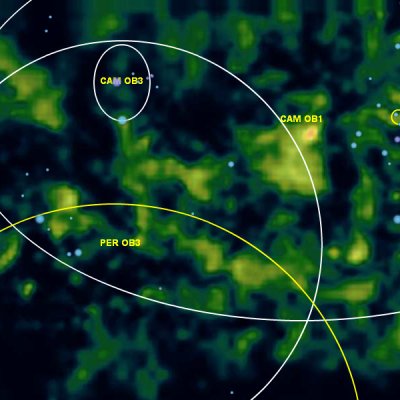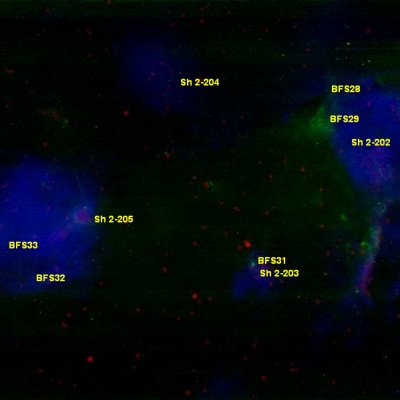
The Camelopardalis molecular clouds and the major ionising stars and associations in this sector are shown in this microwave image. The dense CO region at the upper right is associated with the young stellar object RAFGL 490 and the reflection nebula BFS 29.
Source: Galactic Plane Explorer microwave image
The Camelopardalis molecular clouds and the Cam OB1 association form part of the outer boundary of the Orion spur, our local galactic region, and are located at a distance of about 800 to 1000 parsecs. To the west at about 2000 parsecs is the beginning of the Cassiopeia arc, the brightest part of the Perseus Arm as seen from our solar system. The Cam OB3 association, which likely ionises the HII region Sh 2-204, is located far beyond these regions in the Outer arm. In the foreground are the Per OB3 association, and the Stock 23 and Alpha Persei star clusters, all of which are part of the Gould Belt, the ring of bright stars through which our Sun is currently travelling.
The Camelopardalis molecular clouds are most visible in microwaves around (142°, 2°). This complex was catalogued by Japanese astronomer A. Obayashi and colleagues in the 1990s. Their catalog of 119 molecular clouds from galactic longitude 130° to 160° was described in a paper published in 1999. [1] Unfortunately, this catalog does not appear to have been published and so the exact catalog numbers for these clouds are unknown.
The brightest part of this cloud complex in microwaves is near a region prominent in infrared. This infrared region is called GAL 142.25+01.43 (IRAS 03235+5808, RAFGL 5095) and seems to be associated with the young stellar object IRAS 03236+5836 (RAFGL 490), as well as the reflection nebula BFS29, which is illuminated by the A0Iab class supergiant CE Camelopardalis (HD 21389).
The young stellar object RAFGL 490 is a 8-10 solar mass B2-3 class star, located at a distance of about 1000 parsecs, and surrounded by a large rotating disk of gas and dust. [2] Such disks are believed to potentially evolve into planets and so this system has been the subject of several scientific papers.

The most prominent nebulae in this sector are Sh 2-202 and Sh 2-205, both relatively nearby in the Orion spur. They are most obvious in hydrogen-alpha (shown in blue in this composite image).
Source: Galactic Plane Explorer composite image
The HII region IRAS 03064+5638, also bright in infrared and microwaves, is located further south at (141°, -1°) and contains the bright infrared star cluster [BDB2003] G141.08-01.06. One recent distance estimate for this region is 4100 parsecs. [3] although an analysis of the larger region puts most of the nearby objects at 2000 parsecs. [4] Immediately below this area is Lynds bright nebula LBN 679, visible in hydrogen-alpha, and estimated to lie at a distance of about 2000 parsecs. This coincides with the western edge of a large spur of atomic hydrogen gas in the Perseus Arm and may be energised by photons emitted by W5 to the west. [4]
Russeil combines the extended HII region Sh 2-203 (LBN 685) with the better known nebula BFS31 into one star formation region [5] and derives a distance of 1710 parsecs. BFS31 contains the infrared cluster [BDS2003] 59 [6] and is believed to be associated with the infrared source and HII region RAFGL 5094. [7]
To the northwest is Sh 2-202 (LBN 677), located at a distance of about 800 parsecs and illuminated by low mass young stellar objects within the Camelopardalis OB1 association. [4] Sh 2-205, which is believed to be ionised by the O8 star HD 24451 [8], lies at a similar distance. The 32 million year star cluster Stock 23 sits in front of Sh 2-202 at the even closer distance of about 380 parsecs. Stock 23, the association Per OB3 and the Alpha Persei star cluster are all part of the local Gould Belt ring of stars through which our Sun is currently travelling.
According to Humphreys's catalog of OB associations, Cam OB3 is located at a distance of 3310 parsecs, placing it at the close edge of the Milky Way's Outer arm, which is believed to stretch from 3 to 5 thousand parsecs in this direction. [9] A recent study places Cam OB3 at a distance of 4230 parsecs. [10] The HII region Sh 2-204 is close in the sky to Cam OB3. Avedisova says that Sh 2-204 is likely ionised by four O-class stars that are part of Cam OB3 at 3600 +/- 500 parsecs [11] and Russeil more recently derived a similar estimate of 3830 +/- 260 parsecs. [5] However, another study connects Sh 2-204 to the much closer Cam OB1 association. [9]
Nebulae in this sector
Notes
1. ^ Obayashi, A., Yonekura, Y., Mizuno, A., Ogawa, H., & Fukui, Y. 1999, Star Formation 1999, Proceedings of Star Formation 1999, held in Nagoya, Japan, June 21 - 25, 1999, Editor: T. Nakamoto, Nobeyama Radio Observatory, p. 84-85, Molecular Clouds in Camelopardalis
2. ^ Schreyer, K., Semenov, D., Henning, Th., & Forbrich, J. 2006, Astrophysical Journal, A Rotating Disk around the Very Young Massive Star AFGL 490
3. ^ Klein, R., Posselt, B., Schreyer, K., Forbrich, J., & Henning, Th. 2005, Astrophysical Journal Supplement Series, A Millimeter Continuum Survey for Massive Protoclusters in the Outer Galaxy
4. ^ Karr, J. L. & Martin, P. G. 2003, Astrophysical Journal, Three Lynds Bright Nebulae
5. ^ Russeil, D., Adami, C., & Georgelin, Y. M. 2007, Astronomy and Astrophysics, Revised distances of Northern HII regions
6. ^ Bica, E., Dutra, C. M., Soares, J., & Barbuy, B. 2003, Astronomy and Astrophysics, New infrared star clusters in the Northern and Equatorial Milky Way with 2MASS
7. ^ Chen, P. S., Gao, H., & Xiong, G. Z. 1995, Astrophysical Journal Supplement Series, IRAS LRS Spectra of the Sharpless H II Regions
8. ^ Zdanavicius, J., Cernis, K., Zdanavicius, K., & Straizys, V. 2001, Baltic Astronomy, Photometric Classification of Stars and the Interstellar Extinction near the Camelopardalis and Perseus Border
9. ^ Zdanavičius, J., Zdanavičius, K., & Straižys, V. 2005, Baltic Astronomy, Space Distribution of Stars in the Direction of the Association Cam OB3
10. ^ Zdanavičius, J., Zdanavičius, K., & Straižys, V. 2005, Baltic Astronomy, Interstellar Extinction in the Direction of the Association Cam OB3
11. ^ Avedisova, V. S. & Kondratenko, G. I. 1984, Nauchnye Informatsii, Exciting stars and the distances of the diffuse nebulae






